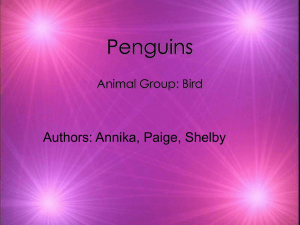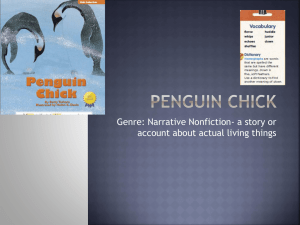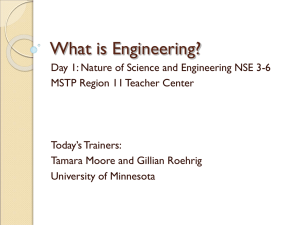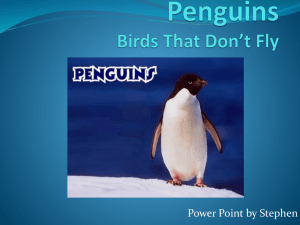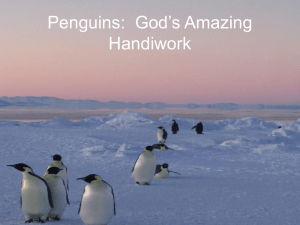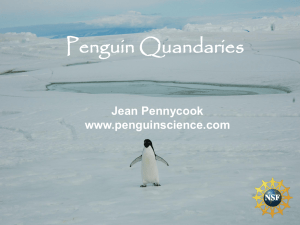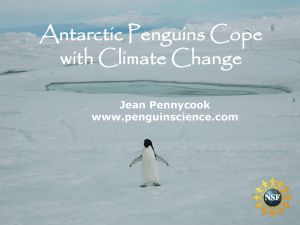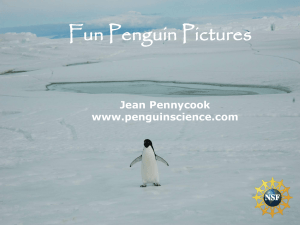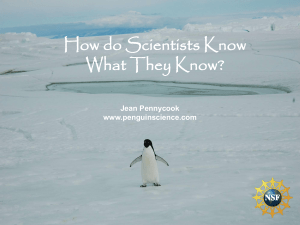Presentation (PPT - 1.4 MB)
advertisement
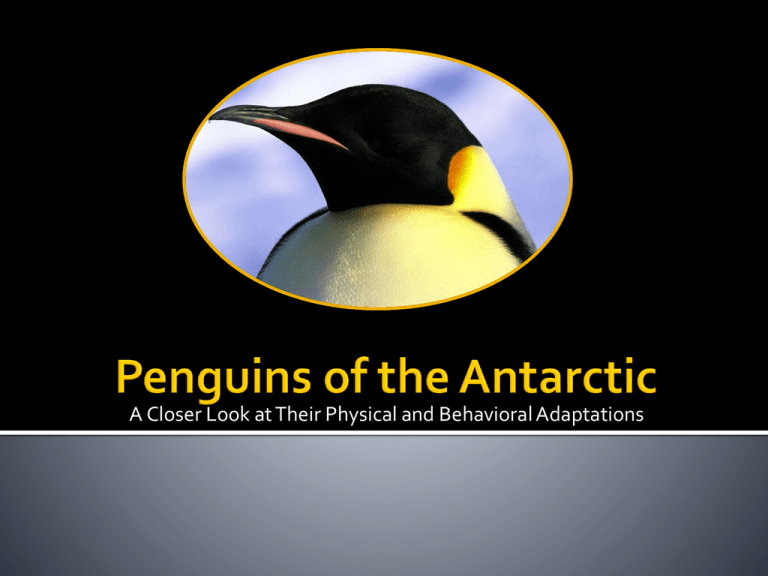
A Closer Look at Their Physical and Behavioral Adaptations Photo by Paul Nicklen, National Geographic •Approximately 40 species of penguins in the fossil record. •Most likely penguins evolved from a small-sized ancestor that was capable of flight. •17 species of modern penguins worldwide—all residing in the Southern Hemisphere* •Highest diversity of penguin species found near the sub-Antarctic islands •Antarctic penguins belong to three families—Aptenodytes “wingless diver”, Pygoscelis “brush-tailed” and Eudyptes “true diver”. •Early explorers mischaracterized penguins as fish due to their swimming ability. *Galápagos penguins take advantage of the cold-water Humboldt current that swings around the islands, thereby allowing them to breed a few miles across the equator into the Northern Hemisphere. Photo by: Doug Allen, Getty Images •Hydrodynamic body “fat in the middle and tapered at both ends” •Keel-shaped sternum and powerful pectoral muscles for swimming and diving •Head retracts slightly underwater to reduce drag •Dense bones to help them dive •Wings shortened, and wrist and elbow joints fused which creates sturdy paddles for swimming. •Legs shortened (knees and upper legs located up inside the body!) and set-back, with paddle-shaped feet for steering underwater. Photo by: Maria Stenzel, Nat. Geographic •Emperor penguins are capable of some of the deepest and longest dives of any penguin species. This is due in part to: •Higher concentrations of the blood protein hemoglobin and the muscle protein myoglobin allow penguins to store 2.5 times more oxygen per unit of body mass than humans. (Norris 2007) •Special properties of their hemoglobin helps it to bind with the last remaining oxygen in their lungs. •During dives—even when chasing after fish—their heart rate slows down to 5 beats per minute. This reduces oxygen demand. •Penguins also likely have reduced blood flow to their extremities during dives. Photo: Dave Houston, penguin.net.nz •Beaks elongated for fish-dominant species like the Emperor. •Beaks short and wide for the krill-dominant species like the Rockhopper. •Beak and throat lined with angled spikes that point inward to grasp food and keep it moving towards the stomach. •Penguins have no external ears, which is an advantage in a very cold climate (you don’t need to worry about your ears freezing off!) •Ear holes are covered with feathers to keep water out. •Penguins have an acute sense of hearing to locate mate and then offspring in a crowded rookery. •Penguins secrete excess salt from glands near their eyes. This allows them to safely drink ocean water. Photo by: Carlie Reum, NSF •Feathers are shortened, stiffened and overlapping for waterproofing. •Approximately 70 feathers per square inch •Feathers coated with oil (preening) produced by a gland near the tail. •Fluffy aftershaft near the base of each feather creates a downy layer of insulation near the body. •Penguins go through a complete molt every year—usually after the breeding season—to replace worn out feathers. New feathers grow up underneath the old ones. •Coloration—dark from above and white from below—makes it more difficult for predators and prey to see them. Dark feathers also absorb heat from the Sun. •Penguins usually have a one-inch layer of fat beneath the skin for additional insulation. Photo by: Caroline Gilbert 2006 •A penguins internal body temperature is between 100-102˚ F •Penguins bring their flippers close to stay warm and raise them to cool off. •When incubating their eggs in the cold Antarctic winter, male Emperor penguins will form a large huddle to stay warm. It gets so warm on the inside of the huddle that the penguins rotate to the outside to cool off. •http://video.nationalgeographic.com/video/news/animalsnews/antarctica-emperor-penguins-huddle-vin/ Photos by: penguinscience.com •Penguins fluff their feathers—thereby trapping more air—when they want to stay warm. (photo above left) •Penguins ruffle their feathers—to release the insulating layer of air—when they need to cool down. (photo above right) •Penguins preen—use their beak to groom their feathers—to keep them in good shape. First they remove dirt and water, and then they spread oil on their feathers to keep them waterproof. •Sometimes penguins preen each other, called allopreening, which increases social bonding. Photo by: Alex Scott •Penguins eat fish, squid and krill (a small shrimp-like crustacean). Different species prefer different diets to avoid competition. •Penguins “bulk up” their fat layer in preparation for breeding and molting—two events during which they go long periods without food. •Most penguin species porpoise (see picture above) when at sea looking for food in order to take a breath without slowing down. •Penguins catch and eat prey while swimming. Photo by: Daniel J Cox, Getty Images • Some penguin species mate with the same partner for multiple years. The likelihood of re-pairing decreases with increasing latitude and decreasing length of breeding season. (In other words, no time to hang out and wait for your prior mate to come back.) •Adélies re-pair approximately 60% of the time, and they have a very short breeding season since they are one of only two species to breed on the continent. •Gentoos, in contrast, re-pair 90% of the time because they have a longer breeding season in the sub-Antarctic islands. Photo by: Anne Owen • In most penguin species, males and females take turns incubating the egg and tending to the young so that the other parent can go to sea to hunt. •The returning parent regurgitates food into the mouth of the chick. •Chicks join crèches (a large group of chicks, sometimes with an adult “nanny”) around 3-6 weeks of age so that both parents can hunt for food. •The age at which different penguin species fledge (molt to adult feathers and go to sea) depends on the time of year when their food source is most abundant. “At the place where they most often went in, a long terrace of ice about six feet in height ran for some hundreds of yards along the edge of the water, and here, just as on the sea-ice, crowds would stand near the brink. When they had succeeded in pushing one of their number over, all would crane their necks over the edge, and when they saw the pioneer safe in the water, the rest followed.” --George Murray Levick Surviving member of Scott’s Terra Nova Expedition 1910-12 Describing Adélie penguins 1. "Dive Site." Enchanting Seabirds. N.p., n.d. Web. 16 Nov. 2012. <www.thedivesite.co.za/news/186/enchanting-seabirds>. 2. "Penguin Adaptation." Gulf of Maine Research Institute. N.p., n.d. Web. 15 Nov. 2012. <http://www.gma.org/surfing/antarctica/penguin.html>. 3. "Penguins." SeaWorld/Busch Gardens ANIMALS - HOME. N.p., n.d. Web. 16 Nov. 2012. <http://www.seaworld.org/infobooks/Penguins/physical.html>. 4. "Penguins Safely Lower Oxygen to "Blackout" Levels." Daily Nature and Science News and Headlines | National Geographic News. N.p., n.d. Web. 17 Nov. 2012. <http://news.nationalgeographic.com/news/2007/12/071207-penguins-dive.html>. 5. "Penguinscience - understanding penguin response to climate and ecosystem change." Penguinscience - understanding penguin response to climate and ecosystem change. N.p., n.d. Web. 17 Nov. 2012. <http://www.penguinscience.com/index.php>. 6. Schafer, Kevin. "Penguin Planet - photographic book by Kevin Schafer." Kevin Schafer Photography. N.p., n.d. Web. 16 Nov. 2012. <http://kevinschafer.com/penguinplanet/>. 7. Scott, Alex. "Penguins « Photographic Expeditions of Alex Snyder." Photographic Expeditions of Alex Snyder. N.p., n.d. Web. 17 Nov. 2012. <http://axspot.wordpress.com/tag/penguins/>. 8. Shirihai, Hadoram, Brett Jarrett, John Cox, and Guy M. Kirwan. The complete guide to Antarctic wildlife: birds and marine mammals of the Antarctic continent and the Southern Ocean. 2nd ed. Princeton: Princeton University Press, 2008. Print. 9. Soper, Tony, and Dafila Scott. Antarctica: a guide to the wildlife. 5th ed. Chalfont St. Peter, Bucks, England: Bradt Travel Guides ;, 2008. Print. 10. "What do penguins look like? - Physical characteristics of penguins." Patrick de Pinguin: information about penguins, growing your own mint plants. N.p., n.d. Web. 15 Nov. 2012. <http://www.patrickdepinguin.com/penguins/appearance/>.
